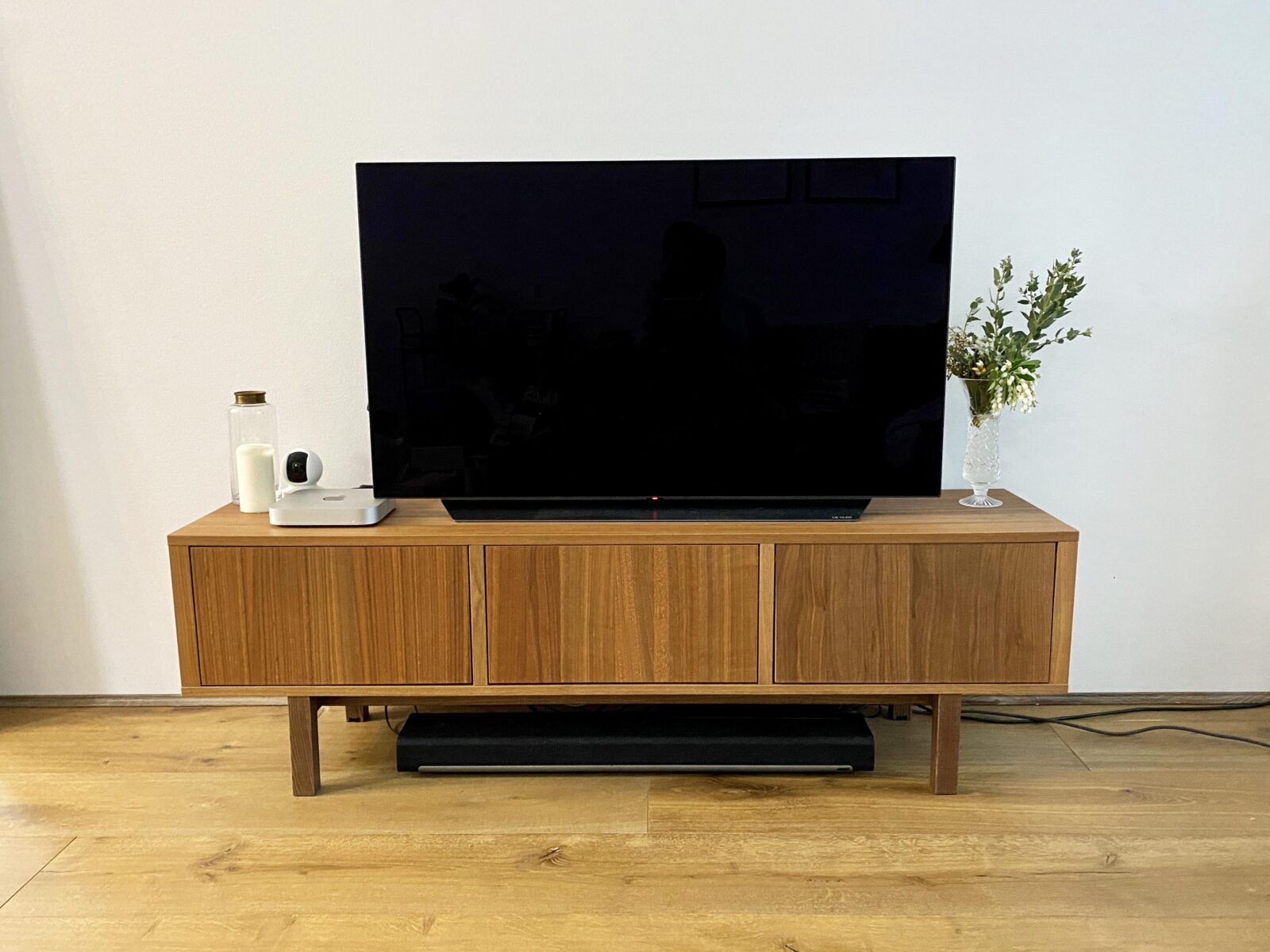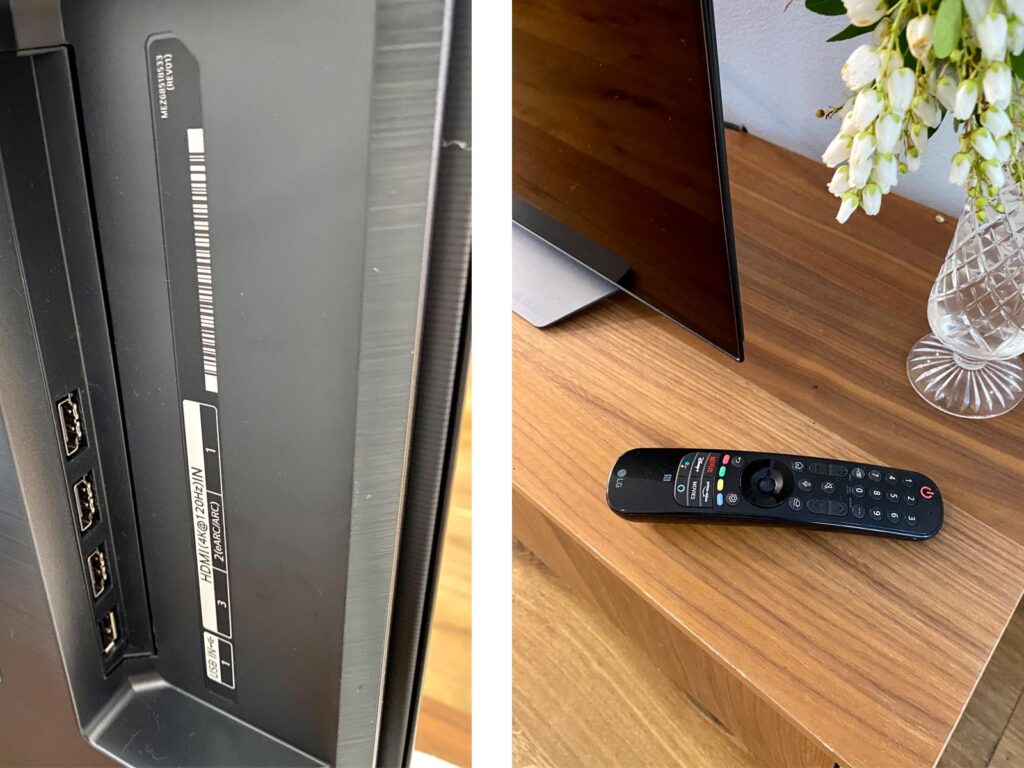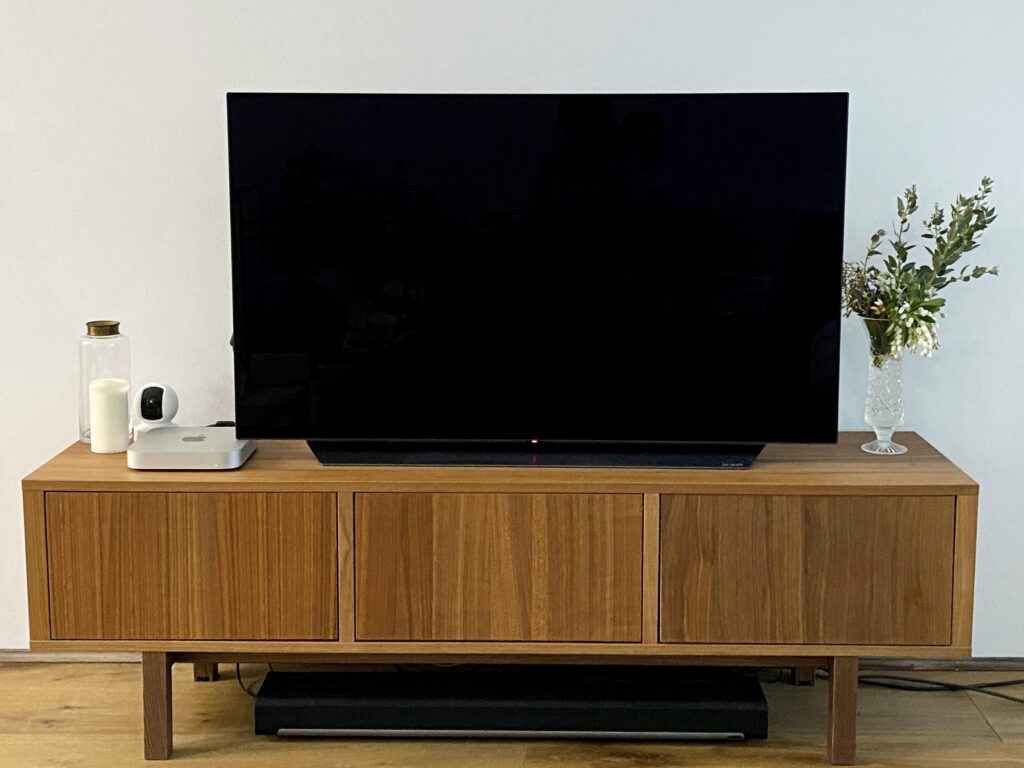LG C1 2021 OLED TV review: is it worth it?

The secret’s out: LG makes great OLEDs. But is it worth copping a smaller one to save some cash? Our LG C1 OLED review shows whether it’s worth the money or not.
Luke Hopewell is a gadget veteran of over 10 years. He’s reviewed over 100 TVs in his time, and been to the magic factory where they’re all made. He’s lost more remotes than he’s found, and if you ask him nicely, he’ll tell you how tech companies get tech writers to review TVs…
Design
The design is classic LG OLED. Inoffensive, minimalistic and smart.
Not much has changed on the C1, which now looks almost identical to the C8 of a few years ago. Even down to the wave stand, and thickness of the bezel. It’s 1cm thick if you’re playing at home.
Even the ports are in the same place as in previous years.

A few on the back (optical out, TV antenna port, etc), and a bunch of HDMI ports on the left hand side. It’s…fine? LG still isn’t catering as well as it should be to people who want to wall mount their C1 OLEDs.
For that sort of consideration, you’re going to want to look at a GX Gallery TV instead for better cable management and a more appropriate wall mount experience.
Of course, that’s going to cost you. Check out our piece on the LG C1 vs GX price to see exactly how much.
New LG Magic Remote
There’s a new Magic Remote with the C1, too. It’s an all-black affair, with a few new smart buttons to reflect the changing times. Previous models had just a Netflix and Amazon Prime Video shortcut key. The new C1 Smart Remote comes with Netflix, Prime Video, Disney Plus and an LG Movies button on the bottom.
The LG Movies button takes you directly to an algorithmically-curated dashboard of movies from all services you have signed in. Like a movie butler robot.
The new Magic Remote also comes with two shortcut keys for both Google Assistant and Amazon Alexa. It’s a smart TV, you see, so it needs multiple voice assistants.

Finally, the improved Magic Remote has an NFC tag built-in. How useful it is depends on which phone you have.
Android users get the most benefit. With your Android phone, you can simply tap the remote and automatically start sharing content from the device onto the TV.
Both iOS and Android users meanwhile can use the LG ThinQ app to share the TVs audio to your smartphone. From there, you can use the existing headphones, AirPods or plug-ins you already have paired to listen to the sound.
OLED picture quality
The bigger a panel gets, the more likely you are to start seeing the limitations of its resolution. A 1080p TV looks great at 40-inches, but blow it up to 80-inches and you start to really see issues.
As we’ve previously mentioned, 4K TVs are 4x the resolution of 1080p. That means when you put it in a relatively small 48-inch format, you’re getting just a truly incredible image.
The colour is so vibrant and the detail is so crisp that uncompressed content almost appears three-dimensional.
Even streaming apps produce an incredible picture thanks to the smarts LG has packed into the C1.

Thanks to the AI Picture program, you’re able to get an awesome experience without actually doing much to calibrate the panel.
LG guesses that you probably don’t want to spend 20 minutes before a movie or show starts tinkering with settings for the perfect image. Mostly because it knows that you’ll never get the perfect image on your own in 20 minutes anyway.
The new Alpha 9 AI Gen4 4K processor in the new C1 models analyses what you’re watching . It also analyses the brightness of the room you’re in and adjusts the image accordingly.
The TV also detects content with embedded Dolby profiles, automatically starting Dolby Vision and Dolby Atmos when available. The panel does experience a slight amount of clipping and blur during action-packed scenes when Dolby Vision is on for some reason, though. The panel looks like it’s trying to over smooth an image that’s moving too fast for it, and I’ve not yet found a way to fix that.
Does the LG C1 OLED burn in?
When LG launched the C1, we asked about burn in.
Burn in is when an OLED panel keeps a shadow or “afterimage”. It happens when a logo, UI or HUD has been on the screen for far too long, causing the panel to burn in.
LG reckons it has TVs with over 3000 hours of active screen time without any burn in. In fact, it says that less than 1% of all repairs coming back to the factory have to be treated for burn in.
The C1 has a bunch of anti-burn in features to make sure it won’t develop an after-image. It subtly shifts the pixels every now and then to keep them from burning. And it “washes” the pixels every so often when you turn off the TV to keep the panel fresh.
One anti-burn in feature that’s a bit annoying, however, is the logo detection feature. It identifies logos that might be on the TV for a while and throws what looks like a drop shadow around them to keep it from burning in.
It’s nifty when being used as a TV, but if you have it on as gaming monitor up close, you definitely notice.
We’ve got more on OLED burn in if you’re worried.
Software
This year’s models all come with LG’s classic WebOS software built-in. I don’t care what anyone says: WebOS is the best TV platform out there. It always works, never breaks and is dead simple to use.
Actually, it used to be dead simple to use. LG seems to be on a mission to make WebOS a little more complicated every single year as it strives to add new features.
If you’re reading this and you design software at LG: stop messing with perfection.
Rather than the Home button taking you to a simple ribbon of apps, it’s now a bespoke screen full of customised content. That’s…fine? Just let me choose to make it a simple ribbon as before so you’re not dragged away from what you’re watching to see what else could be on.
That being said, LG has given the new Magic Remote a more prominent input selection button which allows you to switch your devices way faster than last year’s C10 models.
What’s not so good?
The C1 is great, but there are two things missing here though that I’d love to see.
There’s no bespoke night mode that allows you to automatically set the TV to not blind you when there’s no ambient light available. Nor is there a decent blue light filter mode.
LG will send me an email on that last one, so I’ll explain. There is in fact a blue-light filter mode on the C1. You can turn it on and off in the settings. But just because it’s there, doesn’t mean it’s good. It’s a switch that takes your image and basically just turns it brown/orange. Sure, it removes the blue light, but trashes your image in the process.
One would think with a smart processor and a tonne of gear analysing the image that it could be a little smarter or customisable than just a binary orange mode.
Can you use the LG C1 48-inch as a gaming monitor?
It’s curious, but the worst time you’ll probably have with this TV is if you try to sub it out for a monitor.
Sure, it has the Game Optimiser function and support for NVIDIA G-Sync, but full-time PC monitor use for the C1 leaves a bit to be desired. Mainly due to the size.
If you’re looking for a TV as a monitor, you need to consider the distance you’ll sit from the panel when you use it.
TV manufacturers recommend you sit a distance of 1.5x the screen size away from a 4K TV. For 1080p HD panels, it’s 3x the distance.
That means for a 48-inch panel like the LG C1, you should sit just under a metre (or 3.28 feet) away from the screen for a comfortable viewing experience.
For a 43-inch 4K monitor, the ideal viewing distance is 90cm (or 2.95 feet). That means the C1 48-inch is great for console gaming – where you sit further back – than PC gaming, where one typically sits closer.
All told, it means the C1 48-inch will make you go a little cross-eyed unless you’re ready to sit close to a metre away from it to get the best experience.
When I moved the C1 48-inch from my entertainment unit (2.5 metres away), to my work desk (<~65cm away), a great TV became a bad monitor.
It’s all a little too much until you sit close to one-metre back, to be honest. You see almost every pixel and your eyes can’t adjust to the resolution at such a narrow distance.
A 42-inch panel would mean that viewing distances under 90cm (2.95 feet) would become viable, and LG is set to make one in the next 12 months.
That would make it a great up-close gaming monitor!
Should you buy it?

Here’s the price list for this year’s lineup of LG C1 TVs.
It comes in a smaller size this year at the bottom of the range, with a 48-inch model available for the first time. It then goes all the way up to 83-inches, with an impressive price tag attached.
LG OLED C1 (4K) price list (2021)
| 48-inch: | $AUD3359 |
| 55-inch: | $AUD3959 |
| 65-inch: | $AUD5399 |
| 77-inch: | $AUD10,199 |
| 83-inch: | $AUD14,399 |
Here’s what’s interesting though. These are the recommended retail prices for these TVs, but you’ll never pay that much for them.
If you walk into any store in the world selling these TVs, you’ll see stickers as low as $AUD2300 for the 48-inch model, and $AUD2500 for the 55-inch.
This makes it an insanely attractive purchase. One that’s even making me think it might be time to replace my OLED for the latest model.
Of course you should. If you have $2500 to spend on a TV, you can’t do better than this.
Perfect black performance; unmatched colour; simple design, and incredibly future-proof thanks to HDMI 2.1 and a tonne of AI picture modes.
We tested the 48-inch model, and it was astounding. At $2300, it’s a steal. But if you can afford the extra $200 to go up to 55-inch, you should definitely do that. Especially if you’re going to be sitting more than two metres (6.5 feet) away from your TV to use it.
You won’t be disappointed.
Read more
LG has both OLED and Nanocell tech, but which is better? We break down the difference between OLED and Nanocell.
Luke Hopewell is the editor and co-founder of Redaktör. He's previously been the Editor of Gizmodo, Founding Editor of Business Insider Australia, Editorial Lead for Twitter Australia and more.


